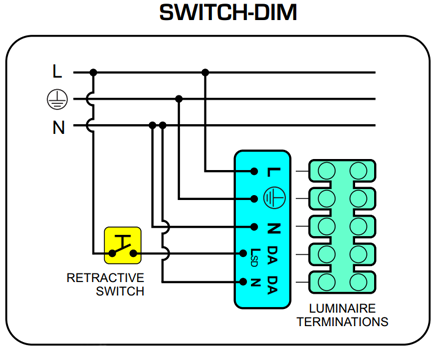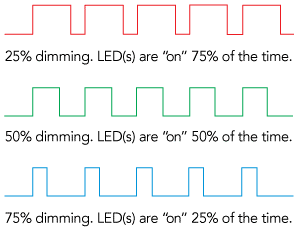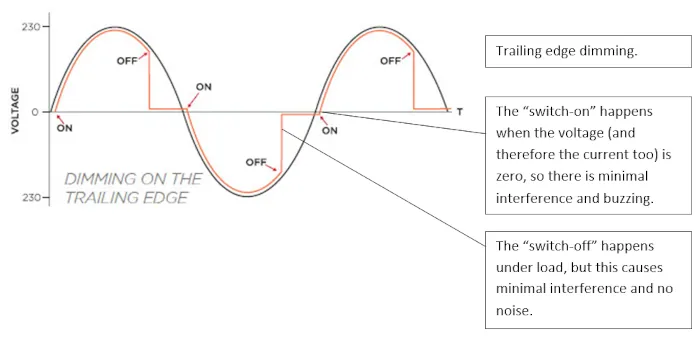Dimming means reducing the output of a lamp or lighting fixture.
The output of a lamp or lighting fixture is measured in lumens (lm) and is sometimes known as its “luminous flux”. As a lamp or fixture is dimmed its lumen output decreases.
Yes, all LEDs can be dimmed, but it is not always simple. If it is practical or not to dim a particular LED lamp or lighting fixture will depend on the driver that is being used to control it. So, to answer the question “Can these specific LEDs be dimmed?” it is necessary first to understand a little about LEDs and drivers.
All LEDs need a driver, which is a piece of electronics. Its main function is to run the LEDs at the correct voltage and current, converting the mains AC supply (typically 230V, 50Hz) to, usually 12 or 24V DC. This is necessary because LEDs don’t operate on mains. LEDs work at low voltages on direct current.
In commercial lighting fixtures, such as LED panels, downlights and spotlights, the driver is usually separate from the fixture. This means that the driver is accessible to the installer so that, if the driver is the appropriate type, dimming control wires, in addition to the mains supply wires, can be connected to it.

An LED panel with its driver. The driver is separate from the panel, so it is accessible for the connection of dimming control wires if required.
In LED lamps the driver is built-in and cannot be accessed. The LEDs and driver come as a single sealed item.

An LED lamp. The driver is in the lamp base and the unit is sealed, so there is no possibility of connecting any dimming control wires.
So, to answer the very general question “Can LEDs be dimmed, and how do you do that?” one first has to determine if the driver is separate and accessible or if it is integrated with the LEDs.
If the driver is separate from the lighting fixture, or is accessible within it, then the best way to dim the LEDs will be by using a dimming driver. This is how most dimming is achieved in commercial and industrial installations.

Installing a common design of commercial light fitting. The LED driver – seen here to the left of the picture – is a separate item and is accessible to the installer.
If desired, the driver can be the dimming type, performing the twin functions of a driver (transforming the incoming power from 230V AC to 12-24V DC) and a dimmer.
A dimming driver performs two functions: it is both a driver and a dimmer.
As a driver it converts the mains AC supply (typically 230V, 50Hz) to 12-24V DC. This is necessary because LEDs don’t operate on mains. LEDs work at low voltages on direct current.
As a dimmer it raises and lowers the amount of electrical energy flowing out to the LEDs. There are two mains ways that a driver does this - pulse width modulation (PWM) or amplitude modulation (AM) - and these are discussed below. However, if a driver uses PWM or AM is generally of little interest to an installer or specifier. They are internal to the driver and have little or no effect on the end user and the quality of the dimmed light they will see. The more important question for the specifier and installer is how the driver is to be instructed to make the LEDs brighter or dimmer.
There are several ways to control a driver, or instruct it what to do. In each case the driver will require a continuous supply of mains power plus a control signal to tell it what to do. The most common methods of controlling a driver are as follows:
DALI (Digital Addressable Lighting Interface). DALI is the most widespread communications protocol for commercial lighting control in use today. A DALI signal is delivered to the LED driver(s) via two wires that are in addition to the wires delivering the mains supply. Many manufacturers supply LED drivers that will accept a DALI input. For more information please read the article "What is Dali?"

This is how a DALI driver would normally be wired.

This is how a 1-10V driver would normally be wired.

This is how a driver would be wired for switch dim, touch dim or push dim control.
A dimming driver has two functions:


Examples of dimming drivers as would commonly be used in or alongside commercial/industrial LED light fittings. Both these units perform dual functions; they are both a driver and a dimmer.
To function as a dimmer they both have extra terminals where control wires can be connected to provide a dimming control signal.
Drivers may use either of two techniques to reduce the amount of energy flowing to the LEDs.

An LED driver that dims by using PWM is switching the power to the LEDs on and off. The longer the “on” pulses and the shorter the “off” pulses, the brighter the LEDs will appear to be, and vice versa. Provided this takes place at a frequency greater than about 200Hz any flickering will not be visible to the human eye and the brain will average the perceived level of brightness.
Some LED driver manufacturers use a combination of PWM and AM to achieve an optimal performance.
With most LED lamps the driver is sealed inside. This is also true of many fittings designed for residential use. In both cases there is no means of delivering to the driver any sort of dimming control signal. Therefore, if dimming is required it must be done by fitting an external dimmer to the incoming mains supply to the LED lamp or sealed fixture.

A widely used type of LED lamp. The driver, which converts the incoming mains supply (230V AC) to low voltage DC, is located in the base of the lamp. If it is designed to be “dimmable”, this lamp could be dimmed with a suitable dimmer fitted on the incoming supply to the lamp.

A fire-rated downlight, popular for residential use. The driver is sealed in the housing with no provision for connecting a dimming control wire. Like a dimmable LED lamp, this could also be dimmed with a suitable dimmer fitted to the incoming supply.
This has a significant impact on the design of the driver in the lamp or fitting. An external dimmer increases and decreases the amount of electrical energy flowing into the LED lamp or sealed fitting and it usually does this by switching the supply off and on (for a variable duty cycle) at 50Hz. If the driver is to work under these conditions it has to be designed accordingly. This gives rise to the concept of a “dimmable or non-dimmable” LED lamp or driver.
A dimmable LED lamp is one which is designed to be dimmed by an external (separate) dimmer. However, even a dimmable LED lamp might not be suitable for use with all types of dimmer, so it is important to check what sort of dimmer is recommended for the LED lamp or fixture you wish to dim. The next section (below) describes the main types of dimmer that are available.
A non-dimmable LED lamp or fixture is just that. It is not designed to be dimmed at all.
The most common LED dimmers are phase-cutting dimmers.
All phase-cutting dimmers work by switching the AC mains supply to the LED lamp on and off twice in every mains cycle. This has the effect of reducing the flow of electrical energy to the LED lamp or fixture, so reducing its light output.
There are two types of phase-cutting dimmers.


Please note that we have been talking here about dimmers that operate on the mains (input) side of an LED lamp or other LED/driver sealed unit. In these applications we talk about LED lamps and LED drivers that are “dimmable” – meaning that they can be dimmed successfully with a separate (suitable) dimmer installed on their mains supply. This approach is most widely used in small and residential situations.
When dimming in a commercial environment we generally use dual-function drivers that incorporate their own dimming capability – see above “DIMMING LEDS WHICH HAVE A SEPARATE DRIVER” – and we call these “dimming” drivers.
To identify the best dimmer to use for a particular LED lamp or sealed LED/driver light fitting check with the manufacturer first. Ask if the item is dimmable. If it is, ask if the manufacturer has a list of their recommended dimmers. If there is no such list and they give no further guidance then follow these steps: